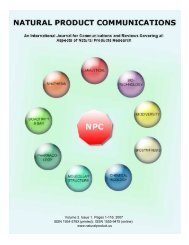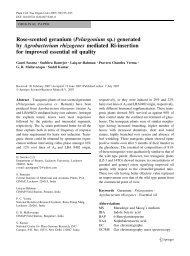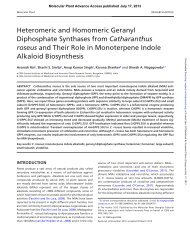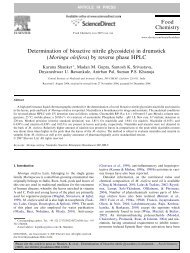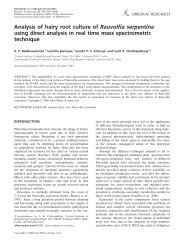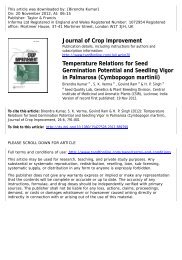Recent advances in plant hepatoprotectives - CIMAP Staff - Central ...
Recent advances in plant hepatoprotectives - CIMAP Staff - Central ...
Recent advances in plant hepatoprotectives - CIMAP Staff - Central ...
Create successful ePaper yourself
Turn your PDF publications into a flip-book with our unique Google optimized e-Paper software.
RECENT ADVANCES IN PLANT HEPATOPROTECTIVES<br />
*<br />
753<br />
4. CURCUMIN<br />
A. Introduction<br />
Curcum<strong>in</strong> (8) is a ma<strong>in</strong> component of rhizomes of ancient spice, turmeric (Curcuma spp. Family:<br />
Z<strong>in</strong>giberaceae). The genus Curcuma consists of hundreds of species that possess rhizomes and<br />
underground root like stems. Turmeric is grown <strong>in</strong> warm and ra<strong>in</strong>y regions of the world such as Ch<strong>in</strong>a,<br />
India, Indonesia, Jamaica, and Peru. Apart from cul<strong>in</strong>ary use, turmeric has been used <strong>in</strong> traditional<br />
medic<strong>in</strong>e for the treatment of jaundice and other disorders of liver, parasitic <strong>in</strong>fections, ulcers,<br />
<strong>in</strong>flammation of jo<strong>in</strong>ts, various sk<strong>in</strong> diseases, etc.<br />
B. Chemistry<br />
Curcum<strong>in</strong>oids are a mixture of several structurally close phenolic compounds present <strong>in</strong> the rhizomes<br />
of turmeric (approximately 3–5% w/w). Three curcum<strong>in</strong>oids of major occurrence are curcum<strong>in</strong><br />
(60–80%), demethoxycurcum<strong>in</strong> (10–20%), and bisdemethoxycurcum<strong>in</strong> (5–10%). 60 Chemically,<br />
curcum<strong>in</strong> is a diferuloylmethane hav<strong>in</strong>g a diferulic acid moiety fused with another carbon atom or<br />
methylene moiety. Thus, it has a methylene-1,3-diketo group show<strong>in</strong>g keto-enol tautomerism due to<br />
stabilization by hydrogen bond<strong>in</strong>g. Curcum<strong>in</strong> exists ma<strong>in</strong>ly <strong>in</strong> keto-enol form rather than <strong>in</strong> a diketo<br />
form (Fig. 6). 61<br />
Turmeric got much attention due to its varied medic<strong>in</strong>al properties, and thus, various techniques<br />
like SFC, Microwave assisted, hydrotropy based, high speed countercurrent chromatography, etc.,<br />
have been developed to extract and isolate curcum<strong>in</strong>. 62–66 Although, numerous methods are available<br />
to isolate curcum<strong>in</strong>, its purification is still time consum<strong>in</strong>g and hence, mostly it is available <strong>in</strong> the<br />
market as a mixture of three ma<strong>in</strong> curcum<strong>in</strong>oids (8, 9, and 10, Fig. 7).<br />
Curcum<strong>in</strong>oids are highly conjugated phenolic compounds which show a strong UVabsorbance<br />
between 420 and 430 nm. 67 Several HPLC methods have been developed to determ<strong>in</strong>e the curcum<strong>in</strong><br />
content <strong>in</strong> the curcum<strong>in</strong>oids rich fraction. 68–70 Hepatoprotective activity of curcum<strong>in</strong>oids were also<br />
determ<strong>in</strong>ed by bioactivity guided fractionation of ethyl acetate soluble fraction of rhizomes of<br />
C. longa. 60<br />
C. Biological Activity<br />
The extracts of C. longa rhizomes exhibited protective activity aga<strong>in</strong>st CCl 4 -<strong>in</strong>duced liver <strong>in</strong>jury <strong>in</strong><br />
vivo and <strong>in</strong> vitro. 71 Curcum<strong>in</strong> has a very good antioxidant activity. Most of its biological activities are<br />
considered due to this only. It <strong>in</strong>hibits lipid peroxidation <strong>in</strong> rat liver microsomes, erythrocyte<br />
membranes and bra<strong>in</strong> homogenates. A few are described below:<br />
(i) Curcum<strong>in</strong> has been found to have protective effects on CCl 4 <strong>in</strong>duced hepatic cytochrome<br />
P450 (CYP) damage <strong>in</strong> rats. 72 The CYP isozyme <strong>in</strong>activation <strong>in</strong> rat liver caused by CCl 4<br />
was <strong>in</strong>hibited by curcum<strong>in</strong>. Treatment with curcum<strong>in</strong> on fibrotic rats, after hepatic damage,<br />
showed significant improvement as well as restoration of lipid profile, marker enzymes, and<br />
thiobarbituric acid reactive substances to normal. 73<br />
O<br />
HO<br />
HO<br />
OMe<br />
OH<br />
OMe<br />
Medic<strong>in</strong>al Research Reviews DOI 10.1002/med<br />
Figure 6. Keto-enoltautomerism <strong>in</strong> Curcum<strong>in</strong> (8).




